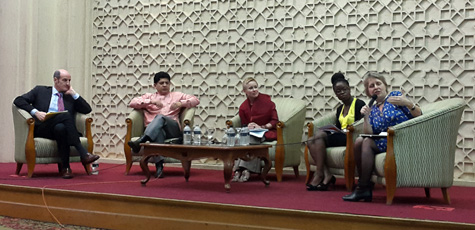via icddr,b
Post-2015 urban health challenges like inclusion, equity and sustainability should be addressed through multi-sectoral action including public-private partnerships, experts say
The inclusion of Sustainable Development Goal 11 in the post-2015 agenda—to make cities and human settlements inclusive, safe, resilient and sustainable—is both a challenge and an opportunity for public health, said a panel of experts at last month’s International Conference on Urban Health in Dhaka. Unabated urbanisation is having a radical effect on urban health, especially because it is widening the divide between the rich and the poor. Among the points that were raised, the panelists emphasised a growing need for multi-sectoral approaches and innovative solutions to delivery of care like public-private partnerships.
The panel, which was led by icddr,b’s Dr Alayne Adams, a senior social scientist with the Director’s Office of the Centre for Equity and Health Systems, featured, in chronological order: Dr Hossain Zillur Rahman, Chairman of the Power and Participation Research Centre, Dr Joyce Mumah, Associate Research Scientist with the African Population and Health Research Centre (APHRC), Dr Godelieve van Heteren, Director of the Rotterdam Global Health Initiative at Erasmus University and Dr Tim Evans, Senior Director of Health, Nutrition and Population at World Bank.
“People have been talking for years about the need to scale up programs, to get sectors to work together and to involve the private sector. But we should really be asking why this hasn’t been possible so far,” said Dr Adams during her opening address. “It’s time to take stock and to figure out creative ways to address the social determinants of health.”
 From left: Dr Tim Evans, Dr Hossain Zillur Rahman, Dr Alayne Adams, Dr Joyce Mumah, Dr Godelieve Van Hetern. Photo: icddr,b / Tanzir Ahmed Shuvo
From left: Dr Tim Evans, Dr Hossain Zillur Rahman, Dr Alayne Adams, Dr Joyce Mumah, Dr Godelieve Van Hetern. Photo: icddr,b / Tanzir Ahmed Shuvo
The challenges ahead: inclusivity, equity and sustainability
The current public health system in Bangladesh has a number of “policy blank spots,” said Dr Rahman, which he argued is the result of policy makers viewing urban health as a “poverty problem.”
The evidence tells us as much: “In one program we saw that the direct causes of maternal mortality have reduced, but maternal deaths are now occurring because of non-communicable diseases; stunting has decreased, but wasting has increased; access to ante-natal care has improved, but access to ante-natal care by trained medical professionals has declined,” he said.
This shows that single-sector projects are effective at improving their area of focus, but they fall short of creating a sustainable urban health momentum. The structural gaps and shifting burdens of disease also cannot be divided by wealth, continued Dr Rahman, and addressing this will require an inclusive, cross-sectional approach.
Innovative solutions: multi-sectoral approaches, public private partnerships and new models of care
“With a cross-sectional/multi-sectoral project we are able to tell policy-makers that by combining X, Y and Z then we get this impact at this cost,” said Dr Mumah. These types of projects also engage numerous stakeholders and beneficiaries in the process. Unfortunately, she conceded, complex solutions like this are expensive—APHRC’s Partnership for Maternal, Newborn and Child Health multi-sectoral project costs more than USD $20 billion.
This is why public-private partnerships (PPPs) are so important, Dr Mumah continued. APHRC uses PPPs to strengthen existing healthcare infrastructure, provide training opportunities to staff working at these facilities and support the district level authorities. This makes the project more cost-effective and improves the sustainability of the intervention.
New models of care, like those employed in BRAC’s Manoshi project, are also critical for creating inclusive solutions, said Dr Evans. BRAC was able to break down a set of barriers to care, allowing mothers to access resources which they might not have otherwise sought out, by integrating community-health workers into social networks.
Implementation: financing, governance and the need for a new political economy
There are quite a few opportunities for financing these solutions, Dr Evans continued. These could take the form of aggressive cross subsidization schemes that provide opportunities to people from lower means to access care, or satellite clinics from the big hospitals in key slum areas.
But why are best practices like this not already standard practice? Dr Van Heteren pointed out that public health may have become too complacent, and that it is operating within an out of date rhetoric; what’s needed are activities that are based around a deliberative democracy, she said, such as involving new professionals like urban ecologists, walking instead of driving, refusing to accept the necessity of bottled water and facilitating inter-organisational dialogue.
Going forward, Dr Evans also emphasised the need for inclusive governance. The multiple levels of government need incentives to work together and this will require specific bureaucratic mechanisms, he said. All actors in the health sector (public, private, civil society, NGOs and citizens) should be empowered to take responsibility, and we must work to make their voices and actions much better articulated.